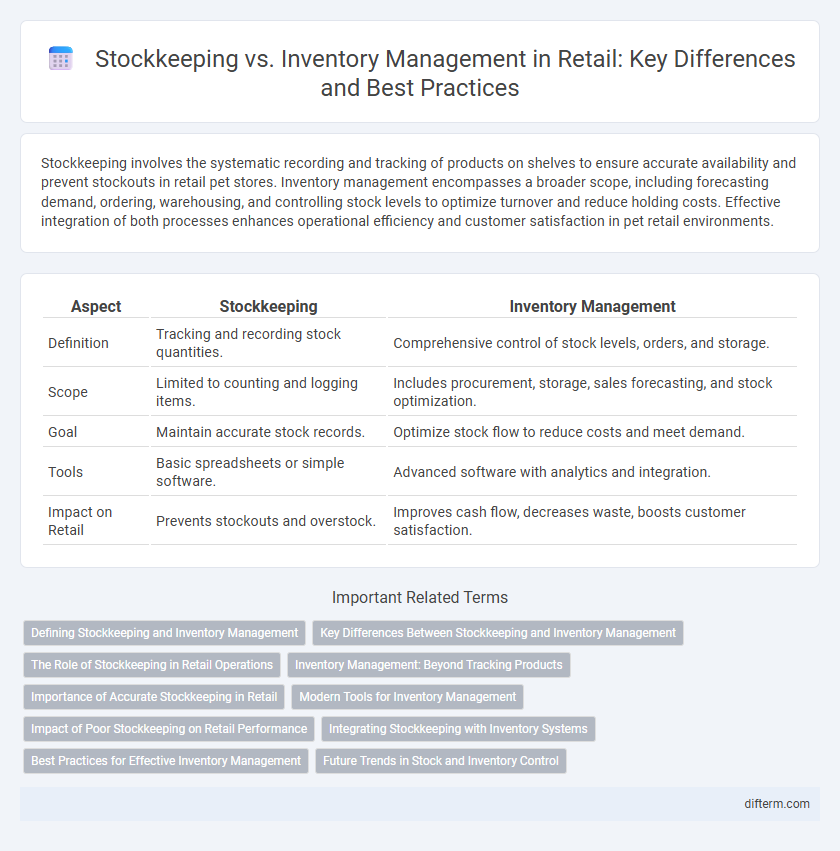Stockkeeping involves the systematic recording and tracking of products on shelves to ensure accurate availability and prevent stockouts in retail pet stores. Inventory management encompasses a broader scope, including forecasting demand, ordering, warehousing, and controlling stock levels to optimize turnover and reduce holding costs. Effective integration of both processes enhances operational efficiency and customer satisfaction in pet retail environments.
Table of Comparison
| Aspect | Stockkeeping | Inventory Management |
|---|---|---|
| Definition | Tracking and recording stock quantities. | Comprehensive control of stock levels, orders, and storage. |
| Scope | Limited to counting and logging items. | Includes procurement, storage, sales forecasting, and stock optimization. |
| Goal | Maintain accurate stock records. | Optimize stock flow to reduce costs and meet demand. |
| Tools | Basic spreadsheets or simple software. | Advanced software with analytics and integration. |
| Impact on Retail | Prevents stockouts and overstock. | Improves cash flow, decreases waste, boosts customer satisfaction. |
Defining Stockkeeping and Inventory Management
Stockkeeping involves the systematic recording and tracking of individual product quantities, locations, and movements within a retail environment to maintain accurate data for replenishment and sales. Inventory management encompasses broader strategies for overseeing stock levels, forecasting demand, optimizing order processes, and minimizing carrying costs to ensure product availability and maximize profitability. Both functions are crucial for streamlining supply chain operations, reducing stockouts, and improving overall retail efficiency.
Key Differences Between Stockkeeping and Inventory Management
Stockkeeping involves the daily task of recording and tracking stock levels to ensure products are available for sale, focusing on individual item details and storage locations. Inventory management encompasses a broader strategy that includes forecasting demand, analyzing stock turnover rates, and optimizing reorder points to maintain ideal inventory levels. While stockkeeping is a component of inventory management, the latter integrates data analytics and supply chain coordination to enhance overall retail efficiency.
The Role of Stockkeeping in Retail Operations
Stockkeeping plays a crucial role in retail operations by ensuring accurate tracking and organization of individual products, which supports efficient inventory management and reduces stockouts. It involves detailed recording of product quantities, locations, and movement within the store, enabling timely replenishment and minimizing shrinkage. Effective stockkeeping directly impacts customer satisfaction and profitability by maintaining product availability and optimizing storage space.
Inventory Management: Beyond Tracking Products
Inventory management encompasses comprehensive processes such as demand forecasting, stock replenishment, and order fulfillment to optimize product availability and reduce carrying costs. Advanced inventory management systems utilize real-time analytics and automation to enhance accuracy, minimize stockouts, and improve supply chain efficiency. Effective inventory management supports strategic decision-making, driving profitability and customer satisfaction beyond basic stockkeeping functions.
Importance of Accurate Stockkeeping in Retail
Accurate stockkeeping in retail is critical for maintaining optimal inventory levels, reducing stockouts, and minimizing overstock costs. Properly recorded stock data enhances demand forecasting and streamlines replenishment processes, directly impacting sales performance and customer satisfaction. Effective stockkeeping integrates real-time tracking systems that support inventory management decisions and improve overall supply chain efficiency.
Modern Tools for Inventory Management
Modern tools for inventory management leverage advanced technologies such as RFID, AI-driven analytics, and cloud-based software to enhance accuracy and real-time tracking of stock levels. These solutions offer automated stock replenishment, predictive demand forecasting, and integration with point-of-sale systems, significantly reducing human error compared to traditional stockkeeping methods. Retailers benefit from improved operational efficiency, optimized inventory turnover, and data-driven decision-making through these cutting-edge inventory management tools.
Impact of Poor Stockkeeping on Retail Performance
Poor stockkeeping in retail leads to inaccurate inventory data, resulting in stockouts and overstock situations that diminish sales and increase holding costs. Inefficient stock monitoring disrupts supply chain operations and hampers the ability to meet customer demand promptly. This mismanagement reduces turnover rates and negatively affects overall retail performance and profitability.
Integrating Stockkeeping with Inventory Systems
Integrating stockkeeping with inventory management systems streamlines real-time tracking of product quantities, locations, and movement, reducing stockouts and overstock situations. Advanced software solutions enable seamless synchronization between point-of-sale data and warehouse inventory, improving demand forecasting accuracy and replenishment efficiency. This integration enhances overall supply chain visibility, resulting in cost savings and optimized stock levels across retail operations.
Best Practices for Effective Inventory Management
Effective inventory management involves accurate demand forecasting, real-time stock tracking, and regular auditing to minimize stockouts and overstock situations in retail. Leveraging advanced software solutions enables seamless stockkeeping, enhancing order accuracy and optimizing replenishment cycles. Implementing consistent inventory categorization and utilizing data analytics are best practices that improve visibility and streamline overall supply chain efficiency.
Future Trends in Stock and Inventory Control
Future trends in stock and inventory control emphasize the integration of AI-driven analytics and IoT technologies to enhance real-time tracking and demand forecasting accuracy. Automation through robotics and blockchain-based systems improves transparency, reduces human error, and optimizes supply chain efficiency. Predictive inventory management leverages big data to minimize stockouts and overstock situations, driving smarter retail operations.
Stockkeeping vs Inventory Management Infographic

 difterm.com
difterm.com